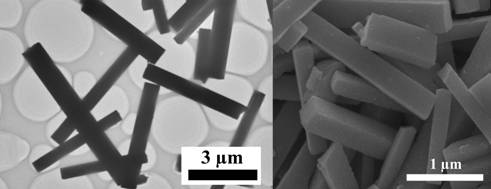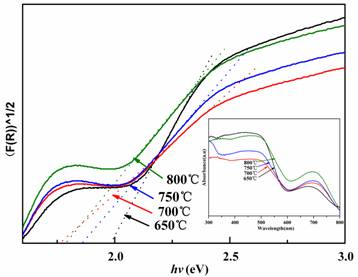Bi2Fe4O9 Submicron-rods Synthesized by a Low-heating Temperature Solid State Precursor Method
Editor: | Mar 26,2013
With the increase of environmental pollution, the ‘‘green’’ technology for air and water purification with solar energy has attracted much interest. TiO2 is undoubtedly an excellent photocatalyst for the oxidative decomposition of many organic compounds under UV irradiation. However, the relatively wide bandgap (3.2 eV) limits its further application under visible irradiation.
Some oxide semiconductors with visible-light-driven photocatalysis such as Bi2Fe4O9, CaBi2O4, Bi6WO12 become a hot topic. These oxides can be applied to the absorption of visible light for their relatively small bandgaps. Prof. XU Jinbao’s research group from Xinjiang Technical Institute of Physics & Chemistry, Chinese Academy of Sciences, explored the low-heating temperature solid state precursor method to synthesize Bi2Fe4O9 submicron-rods. The diameter of Bi2Fe4O9 submicron-rods is about 500-800 nm and the length of them is about 2-4 μm(Fig.1).
Researchers adopted precursor method to further calcine in low-heating temperature range from 600 to 800 °C to directly synthesize novel Bi2Fe4O9 submicron-rods. It turns out that the Bi2Fe4O9 submicron-rods attained at 700℃possess a perfect submicron-rod shape with a smaller bandgap (1.76 eV), which is smaller than the reported value of TiO2 (3.2 eV)(Fig. 2). Based on XRD and SEM result, the structure and morphology of the Bi2Fe4O9 are closely related to reaction temperatures. Due to their good morphology and small bandgap, Bi2Fe4O9 submicron-rods have the potential to be applied to visible-light-driven photocatalyst for environmental cleanup and optoelectric devices for solar energy conversion to electricity.
The work has been published on Journal of Alloys and Compounds (2013, 562, 64–68) and a related patent has been authorized (No.201110045937.7).
The related work was supported by the “Hundred Talents Project” Foundation and Western Light Talent Culture Project of CAS.

Fig.1 TEM and SEM micrographs of Bi2Fe4O9 submicron-rods

Fig.2 Calculated bandgap of Bi2Fe4O9 with the tangent of the linear part as dotted line
附件下载:
 (86) 991-3838931
(86) 991-3838931 lhskj@ms.xjb.ac.cn
lhskj@ms.xjb.ac.cn (86)991-3838957
(86)991-3838957 40-1 Beijing Road
Urumqi, XinjiangChina
40-1 Beijing Road
Urumqi, XinjiangChina